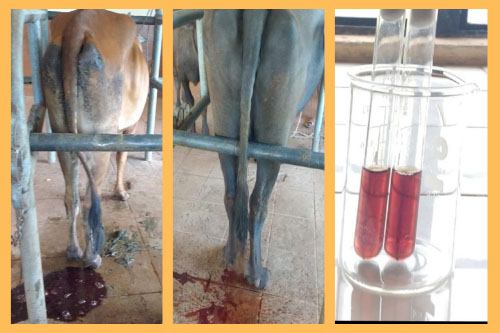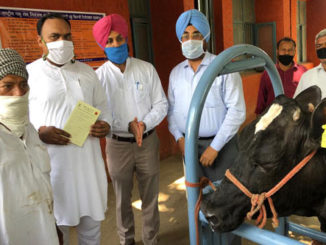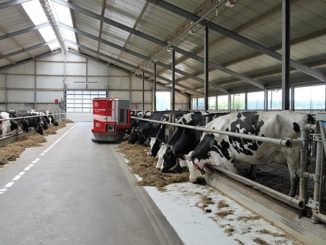Hameoglobinuria is the pathological conditions in animals in which animal passes haemoglobin in the urine. Haemoglobinuria occurs due to mineral deficiency, metabolic diseases, protozoal diseases, infectious diseases and non infectious diseases. Haemoglobinuria commonly occur more in buffalo than cattle. This will causes decrease in haemoglobin in the body of the animals and causes anemia. The other name for hameoglobinuria in common language is lahu mutra, rakta mutra and coffee colour urine. Haematuria is also the pathological state in which the animal passes whole blood in the urine. The difference in haemoglobinuria and haematuria can be done by Occult blood test. Incidence is sporadic in nature. Its metabolic condition caused due to deficiency of phosphorus, common in winter season. Cow and buffalos in 3-6th lactation are more prone. Incidence more common in cows 1-2 weeks of after parturition in cow where as in buffaloes incidence is pre partum and post partum. Post parturient haemoglobinuria is most commonly found in high producing dairy cows on the onset of lactation. Mortality occurs 10-30%.
Causes for hameoglobinuria
Infectious agents:
- Babesiosis caused Babesia species also known as piroplasmosis.
- Bacillary haemoglobinuria caused by Clostridium haemolyticum
- Leptospirosis caused by Leptospira species.
- Staphylococcus and streptococcus infection
Non infectious agents:
- Cold water intake in calves.
- Plant toxicity such as onion, sweet clover, rape, braken fern,turnip mustard and poisonous mushrooms.
- Drugs such as sulfonamide, phenol, turpentine, carbolic acid etc
Metabolic causes
- Phosphorus deficiency
- Copper deficiency
- Avitaminosis
Pathophysiology
The red blood cells covered by the double layer of phospholipids , when hypophosphotemia occurs the intracellular causes increases in the fragility of the RBC cells. Increases the intravascular haemolysis. In the RBC, the reproduction of the intracellular organism occurs which will causes bursting of RBC, causes intravascular haemolysis. Sometimes due to oxidative damage occur in the body due to high intake of poisonous plant causes fragility in the phospholipids and causes intravascular haemolysis and causes haemoglobinuria.
Clinical signs
The animal suffering with haemoglobinuria with common clinical signs are anorexia, dull, depressed, loss of body weight, secondary ketosis and locomotors disturbances, hurried respiration, coffee colour urine output, anaemia, jaundice, pale conjunctival mucous membrane, scanty fecal output, anaemia, hurried respiration, tachycardia, fall in milk yield. Pyrexia observed in Babesiosis, Leptospirosis and Clostridial infections.

Post mortem lesions: Carcass pale and icteric, pale liver with infracts, infracts in gall bladder, red urine in kidney and urinary bladder, jaundice, excessive fluid accumulation in body cavities with reddish tinge.
Diagnosis
- Based on history of intake food and cold water intake, treatment aspect, heavy tick infestation, parturition history within one month and severe fall in milk yield.
- Based on clinical signs: The owner complaint with coffee colour urine, anorexia and above clinical signs are also mentioned when the animal comes to clinic.
- Based on laboratory diagnosis: the urine and blood sample were taken for further confirmation of causative agent.
- The urine sample helps to differentiate from haemoglobinuria to haematuria.
- Blood smear examination of leptospiral organism in dark field microscope.
- The blood smear examination helps in diagnosis of the intracellular organism such as babesiosis.
- Reduction in Red blood cells count and heamoglobin the body,
- Estimation of phosphorus and other minerals.
- Estimation of the poisonous drugs.
- The hinge bodies on the RBC indicated the oxidative stress.
- Based on PCR, rt PCR we can confirm the organism identification.
Differential diagnosis: The haemoglobinuria can be differentiated with haemochuria and causes for haemochuria and other renal disease..
Treatment
Blood transfusion in severe cases will be life saving practice. Based on the causative agent, the treatment will be given such as In babesiosis, the line of treatment is INJ. Oxytetracycline at the dose rate 10mg/kg BW, and inj. Diminazine aceturate at the dose rate 3.5mg/kg BW for alternative days. Clostridium haemolyticum, the line of treatment is INJ. Penicillin 10000-20000 IU/kg BWfor 3-5 days. For plant toxicity and hypophosphotemia inj. Inorganic phosphorus at the dose rate of 5-10 ml per animal for 3-5 days. Some times higher antibiotic required to avoid the secondary bacterial complications in the infected animals.Inj. Sodium bicarbonate at the dose rate 1ml per kg BW given and oral feeding if sodium bicarbonate by 50-100gms helps to avoid the damage to kidney due to in-vascular haemolysis and haemoglobin. Organic, in organic and buffer phosphorus commercial preparation injections with prescribed dosage should be given as a supportive therapy. Oral phosphorus preparations like Sodium acid phosphate powder will also helps in early recovery of animal. The supportive therapy should be given to Mineral mixture, mineral tonic and liver tonic for enhance the liver function and avoid the stress and damage of the hepatocytes. For oxidative damage control, antioxidant such as selenium and vitamin E containing injection should be given as per prescribed dosage. As supportive therapy for recovery of Haemoglobin iron supplements should be given such as for intravenous administration of iron sucrose at the dose of 1ml for 30 kg body weight, intramuscular administration of Inj. Iron folic acid, inferon, iron dextrin at the dose of 1ml for 50 kg body weight and some oral iron supplementation such as iron sulphate tablet, tonics and doses will be given by as per Veterinarian prescription.
Control measures
- The special care should be taken after parturition to avoid post parturient haemoglobinuria in cattle and buffalo. Phosphorus containing mineral mixture should be feed to the animals.
- Avoid cold water to the calf during the winter season.
- Control of ectoparasitic endoparasitic infestation by regular deworming and grooming and washing of the animals.
- Supplementation of oral Phosphorus preparations in winter will reduce the incidence.
- Avoid excessive feeding of onion rape and other plant which causes oxidative damage to the RBC and causing intravascular haemolysis and causes for haemoglobinuria.
- Providing clean drinking water to the animals.
- Avoid heavy metal in the feed additives.
- Animal should be regularly cleaning to avoid external parasitic infestation.
- Regular feeding of mineral mixture to pregnant cows and buffaloes to avoid the hypophosphotemia
- Giving spouts to the animals will also help in early recovery of the animal and avoid the liver inactivation.
- Regular deworming and vaccination along with vitamin and mineral resources will help in the healthy health status of the animal.
Reference
- A Discussion of Hemoglobinuria and Hematuria. R. L. Nelson Volume 17 | Issue 3 1955
- Merck manual
| The content of the articles are accurate and true to the best of the author’s knowledge. It is not meant to substitute for diagnosis, prognosis, treatment, prescription, or formal and individualized advice from a veterinary medical professional. Animals exhibiting signs and symptoms of distress should be seen by a veterinarian immediately. |






Very nice 👌👌